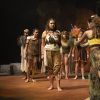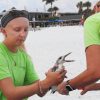When entrepreneur Autumn Blum set out to develop a new line of eco-friendly sunscreens and body care products, she turned to scientists and students at Eckerd College for testing and research.
Blum, a 1997 Eckerd chemistry honors graduate, already had founded and sold a successful cosmetics company, Organix South.
Her new company, Stream2Sea, was inspired by Blum’s commitment to protect the planet, an ethos that reflects the values she absorbed at Eckerd.
“Over 6,000 tons of skin care products enter coral reefs from tourist activities alone,” Blum wrote in a blog post on the Stream2Sea website. “This number doesn’t take into account the products entering our rivers, lakes and streams through runoff, sewage and more. While some brands in the market today claim to be …‘ocean friendly,’ many contain ingredients that are known to harm the fragile ecosystems and marine life of our waters.”
Blum worked with Assistant Professor of Biology Denise Flaherty and Assistant Professor of Biology and Marine Science Koty Sharp and their students to study her products and those of her competitors.
“I had reached out to several universities and research facilities to assist with our testing before selecting Eckerd College,” said Blum. “Working with Alumni Relations and my mentor, Dr. David Grove, we were able to select the appropriate team to conduct our trials. It was wonderful working with the knowledgeable professors and students at my alma mater. Watching the students apply their lab skills and education to my ‘real world’ requirements, proving the safety of Stream2Sea products, was an incredible feeling!”
The company is devoting a significant portion of its start-up costs to testing “so that we can state, with complete confidence, that we are the safest product on the shelves,” Blum wrote. The work already has drawn news coverage in at least 70 cities across the country.
Flaherty tested the products on fish while Sharp tested them on coral larvae. It was a painstaking process that ultimately showed no evidence of harm to fish or to corals.
“We’ve demonstrated that our products are safe for a whole series of species, from the microscopic Caenorhabditis elegans to tank fulls of zebrafish,” Blum wrote. “These students were so excited about the process that they actually cheered when every single fish was still alive after 96 hours of swimming in the shampoo-laced foamy water.”
Sharp and her students also traveled to the Florida Keys to collect coral larvae and test sunscreens at Mote Marine Laboratory’s Tropical Research Laboratory. While sunscreen had been tested before on living corals, tests had never been done on coral larvae, Sharp said. Her tests are extremely sensitive—they not only test whether the products kill the coral larvae, but also whether they affect other critical behavior that enables the corals to develop into adults. Sharp’s experiments suggest that Blum’s products do not negatively affect coral larvae, though that was not the case with some competing brands, even those that are marketed as safe for the marine environment.
Still, Blum is not prepared to say her products are 100 percent marine safe because there are so many unknown factors. “That said, I think that my product line is among the safest available today,” she wrote.
Getting to work on applied research in the field and in the lab was an amazing experience for the students, Flaherty said. “Being able to see a project like this all the way through was very meaningful,’’ she said. And working closely with an Eckerd alumna helped them see what they can do in the real world once they leave the classroom, she said.
Meaningful but also hard work, Sharp said. The field research in particular can be grueling. Rising marine science seniors Takoda Edlund (top photo, below) and Samantha Fortin (bottom photo, below) accompanied her to the Keys. “Coral larval fieldwork is around the clock. Our research team spent a week in the field,” she said. “I’m thrilled that the students got this experience—they learned how to be ready to spring into action as soon as the corals released their larvae. In the field, we work according to the coral’s biological clock, which is not always predictable.”












